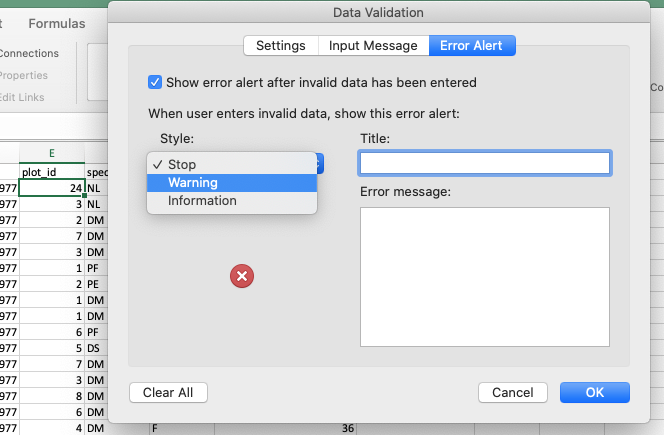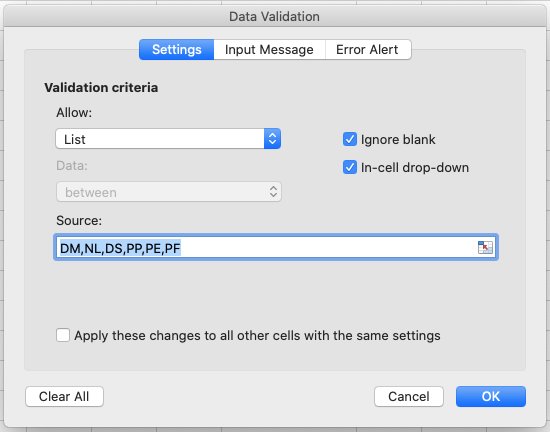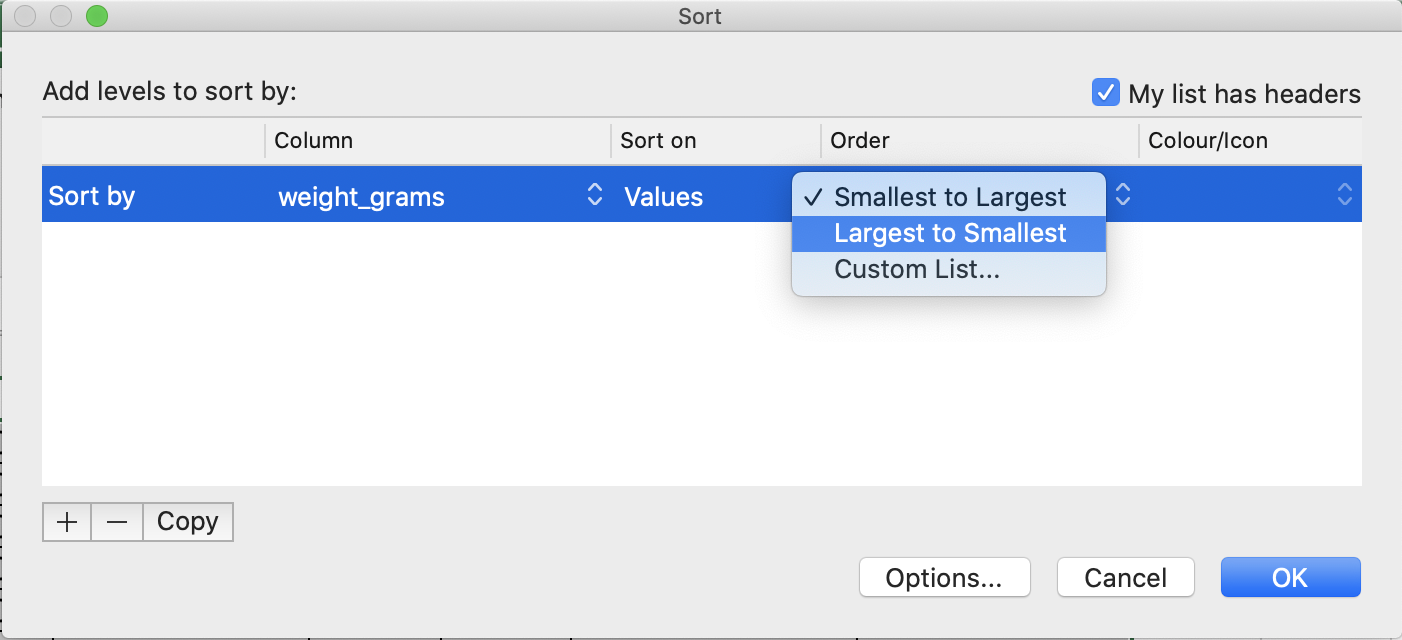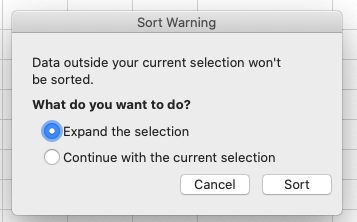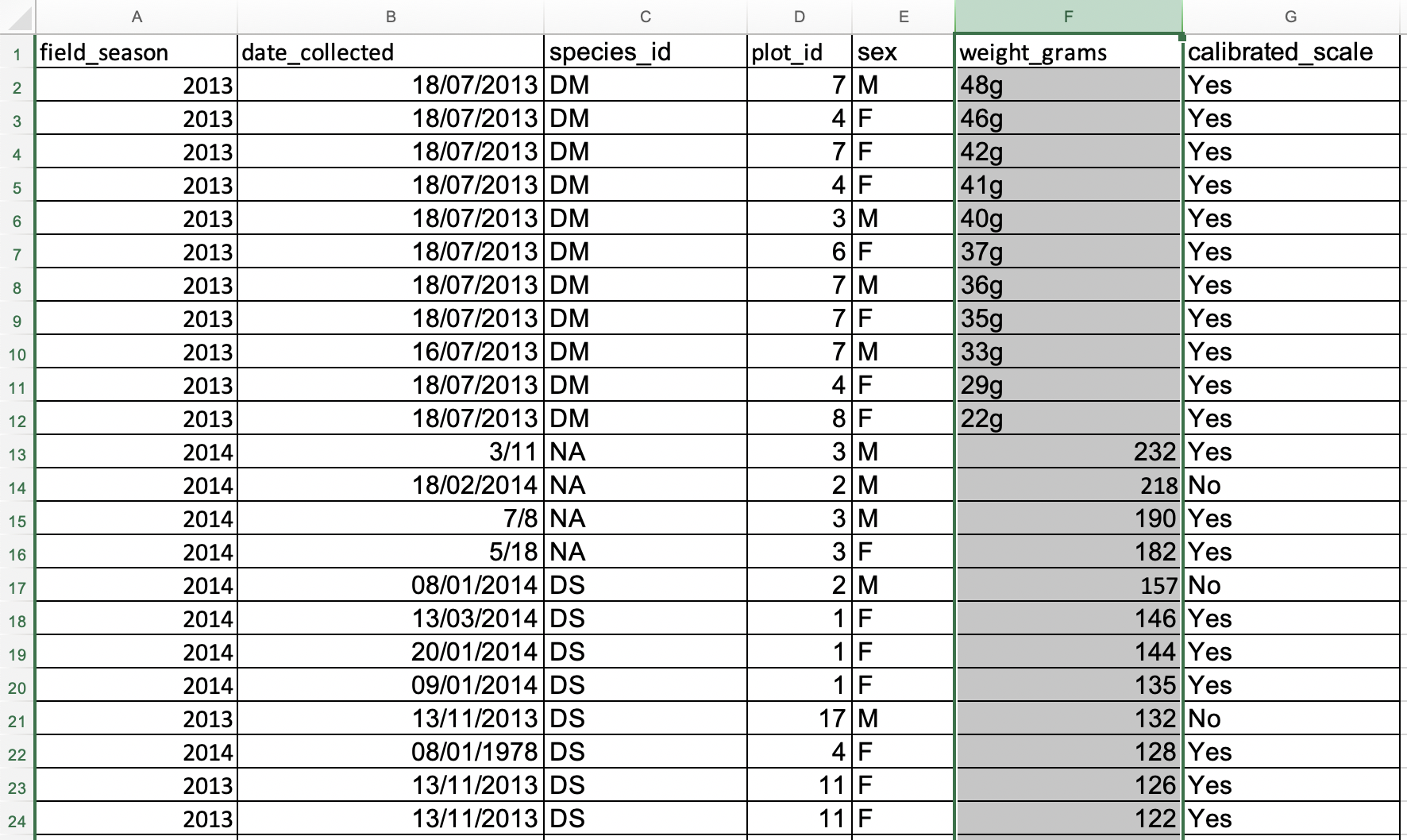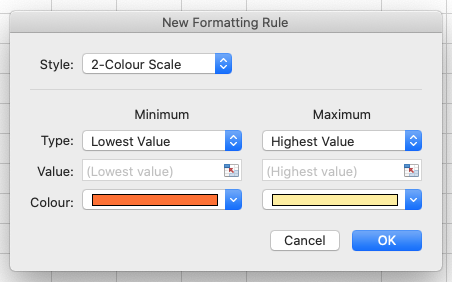Quality assurance and control
Overview
Teaching: 10 min
Exercises: 15 minQuestions
How can we carry out basic quality control and quality assurance in spreadsheets?
Objectives
Apply quality control techniques to identify errors in spreadsheets and limit incorrect data entry.
When you have a well-structured data table, you can use several simple techniques within your spreadsheet to ensure the data you enter is free of errors. These approaches include techniques that are implemented prior to entering data (quality assurance) and techniques that are used after entering data to check for errors (quality control). These techniques can make data entry easier as well as more robust.
Validating data on input
When we input data into a cell of a spreadsheet we are typically not constrained in the type of data we enter. In any one column, the spreadsheets software will not warn us if we start to enter a mix of text, numbers or dates in different rows. Even if we are not facing constraints from the software, as a researcher we often anticipate that all data in one column will be of a certain type (it should be). It is also possible that the nature of the data contained in the table allows us to place additional restrictions on the acceptable values for cells in a column. For example a column recording age in years should be numeric, greater than 0 and is unlikely to be greater than 120.
We will be working with a couple of examples of data validation rules but many others exist. For an overview of data validation rules available in Excel, check out the Excel support page on data validation. General steps to employ data validation are as follows.
-
Open the tab ‘semi-cleaned-combined’ of the messy data spreadsheet. It contains tables from the messy data tabs ‘2013’ and ‘2014’ combined into a single table (you may note that data is not fully yet cleaned, although it is in a much better shape than it was in the tabs ‘2013’ and ‘2014’).
-
Select the column ‘plot_id’.
-
On the
Datatab from the top level menu selectData Validation, orData Toolsand thenData ValidationorValidation Tools(depending on your version of Excel) orValidityin LibreOffice.
-
In the
Allowbox of tabSettingsselect ‘Whole numbers’ of data that should be in the column. Other options include decimals, lists of items, dates, and other values.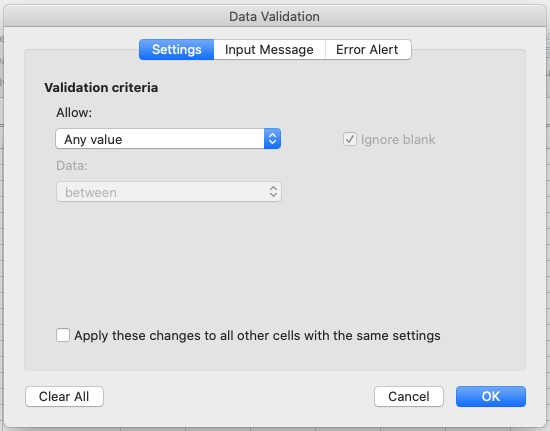
-
Now attempt to enter text into a cell in the ‘plot_id’ column. You should be prevented from doing so, as the column is now locked down to whole numbers only.
Excel allows us to specify a variety of data validations to be applied to cell contents.
If the validation fails, an error is raised and the data we attempted to enter is rejected.
In addition to providing validation when we enter data, Excel allows us to add validations to data that has
already been entered. Note, however, that the validation is not applied retrospectively, so that incorrect data are not removed.
Instead, if a particular cell with a value entered previously fails the validation check - depending on the Excel version -
a triangle may be placed in the top left corner of
the cell as a warning, or you may not get any warning at all (but you may be able to request invalid cells to be
circled from the Data validation drop-down button).
For this reason, it is best practice to set up validations before you start entering data.
Restricting data to a numeric range
Now let’s try this out by setting the ‘plot_id’ in our spreadsheet to only allow plot values that are integers between 1 and 24.
Exercise
Set the ‘plot_id’ column in tab ‘semi-cleaned-combined’ of the messy data spreadsheet to only allow values that are integers between 1 and 24.
Solution
- Open the tab ‘semi-cleaned-combined’ of messy data spreadsheet and select the ‘plot_id’ column.
- On the
Datatab the top level menu selectData Validation, orData Toolsand thenData ValidationorValidation Tools(depending on your version of Excel) orValidityin LibreOffice.- In the
Allowbox of theSettingstab selectWhole number(and in LibreOffice select theDatafield to bevalid range.- Set the minimum and maximum values to 1 and 24.
Now let’s try entering a new value in the plot column that is not a valid plot id. The spreadsheet stops us from entering the wrong value and asks us if we would like to try again.
You can also customise the resulting message to be more informative by entering your own message in the
Input Messagetab (or, in LibreOffice, by selecting theError alerttab and entering a message in theError messagefield).You can also set the invalid data to result in a warning rather than an error by modifying the
Styleoption on theError Alerttab (or theActionfield in LibreOffice).- In newer versions of Excel, you may also have an option to indicate all previous invalid entries once you have entered your restricted values.
You have now provided a restriction that will be validated each time you try and enter data into the selected cells. If you type a value which is not on the list you will get an error message. This not only prevents data input errors, but also makes it easier and faster to enter data.
Restricting data to entries from a list
If you use a list of options to restrict data entry, the spreadsheet will provide you with a drop-down list of the available items. Think about trying to remember how to spell “Dipodomys spectabilis” for species each time you need to enter that value, or whether or not you capitalised the words correctly. By restricting values in cells to a predefined list of values, you can select the right option from the list every time. Let’s apply this to our data.
Exercise
Restrict the values of the ‘species_id’ column in tab ‘semi-cleaned-combined’ of the messy data spreadsheet to allow only values from the following list: “DM, NL, DS, PP, PE, PF”.
Solution
- Open the tab ‘semi-cleaned-combined’ of
messy_survey_data.xlsand select the ‘species_id’ column.- On the
Datatab the top level menu selectData Validation, orData Toolsand thenData ValidationorValidation Tools(depending on your version of Excel) orValidityin LibreOffice.- In the
Allowbox of theSettingstab selectList.- Type a list of all the values that you want to be accepted in this column, separated by a comma (with no spaces). For example, type “DM,NL,DS,PP,PE,PF” (in LibreOffice, skip the commas and add each entry to a new line). Note this is only a small subset of allowed species ids - the whole set is much larger but for the purposes of this exercise we want to show you how to restrict a cell to a list of values and what happens when old data does not conform to this restriction.
- Create a meaningful input message and modify alert error type, as in the previous exercise, then click OK.
- Scroll to the bottom of your data and select a cell in the
species_idcolumn in a new row. When a cell in this column is selected, a drop-down arrow will appear. When you click the arrow you will be able to select a value from your list of allowed values.- In newer versions of Excel, you may also have an option to indicate all previous invalid entries once you have entered your restricted values.
You have now provided a restriction that will be validated each time you try and enter data into the selected cells. If you type a value which is not on the list you will get an error message. This not only prevents data input errors, but also makes it easier and faster to enter data.
Typing a list of values where only a few possible values exist might be convenient, but if the list is longer (e.g.
all allowed species) it
makes sense to create it as a small table (in a separate tab of the workbook).
We can give the table a name and then reference the table name as the source of acceptable inputs when the source box
appears in the Data Validation pop-out. For example, the table of all species can be copied from the
file species.csv and then referenced
in your spreadsheet to provide the list of all valid species names and their abbreviations (ids).
Using a table in this way makes the data entry process more flexible.
If you add or remove contents from the table, then these are immediately reflected in any new cell entries based on this source.
You can also have different cells refer to the same table of acceptable inputs.
Quality control - identifying outliers
Tip: keep your raw data - raw
Before doing any quality control operations, save your original file with the formulas and a name indicating it is the original data. Create a separate file with a new name, and ensure your data is stored as values and not as formulas. Because formulas refer to other cells, and you may be moving cells around, you may compromise the integrity of your data if you do not take this step!
Tip: keep track of your modifications
As you start manipulating your data files, create a
README.txttext file to keep track of your files and document your manipulations so that they may be easily understood and replicated, either by your future self or by an independent researcher. YourREADME.txtfile should document all of the files in your data set (including documentation), describe their content and format, and lay out the organising principles of folders and subfolders. For each of the separate files listed, it is a good idea to document the manipulations or analyses that were carried out on those data. Cornell University’s Research Data Management Service Group provides detailed guidelines for how to write a good README file, along with an adaptable template.
Sorting data
Bad values often sort to the bottom or top of the column. For example, if your data should be numeric, then alphabetical and null data will group at the ends of the sorted data. Sort your data by each field, one at a time. Scan through each column, but pay the most attention to the top and the bottom of a column. If your dataset is well-structured and does not contain formulas, sorting should never affect the integrity of your dataset.
Tip: expand the sort
Remember to expand your sort in order to prevent data corruption. Expanding your sort ensures that the all the data in one row move together instead of only sorting a single column in isolation. Sorting by only a single column will scramble your data - a single row will no longer represent an individual observation.
Exercise
Look at the ‘semi-cleaned-combined’ tab of the messy data spreadsheet. It contains tables from the messy data tabs ‘2013’ and ‘2014’ combined into a single table in a single tab (you will note that the data is not yet fully cleaned).
Sort the
weight_gramscolumn in your spreadsheet program fromLargest to Smallest. What do you notice?Solution
- Select
weight_gramscolumn.- Click the
Sortbutton on the Data tab from the top level menu in Excel (in LibreOffice select theDatamenu and then selectSort.Note that in older versions of Excel you may get just the
Sortbutton without the drop-down menu, followed by a pop up window to specify the column you want to sort and the sort order (shown in figure below).- In the pop-up that appears make sure you select
Expand the selectionto make sure data in other columns is moved together with the data in the column you are sorting.- Note how the odd values sort to the top and bottom of the data. The cells containing no data values sort to the bottom of the tabular data, while the cells where the letter “g” was included can be found towards the top or bottom. This is a powerful way to check your data for outliers and odd values.
Conditional formatting
Conditional formatting allows you to format data based on some criteria, e.g. you can colour code your values by some criteria from lowest to highest. This can also make it easier to scan your data for outliers. Conditional formatting should be used with caution, but it can be a great way to flag inconsistent values or errors when entering data. Let’s apply some to our data.
Exercise
Look at the ‘semi-cleaned-combined’ tab of the messy data spreadsheet and apply any
2-Color Scaleformatting rule to columnweight_grams.Solution
- Select
weight_gramscolumn.- In the main Excel menu bar, click
Home>Conditional Formatting...chooseNew rule(in LibreOffice from theFormatmenu, selectConditionaland thenColor scale).- In the
New Formatting Rulewindow, apply any2-Color Scaleformatting rule. (In LibreOffice selectColor scale (2 entries)from the top-middle drop-down list and clickOK.- Now we can scan through the column and different colours will stand out. Do you notice any strange values?
- Cells that contain non-numerical values are not coloured making them easier to spot. This includes both the cells where the letter “g” was included and the empty cells. They show up at either at the top or at the bottom of the data but may not be as easy to spot if you have a very large dataset and have to scroll a lot.
Scanning for outliers
It is nice to be able to do these scans for outliers in spreadsheets (such as using sorting or conditional formatting), but we can also do these checks in a programming languages like R, Python and SQL, or using OpenRefine - which may be even more suitable if you have larger datasets with, e.g., with 10K+ or 100K+ rows which are difficult to scroll down to the bottom of to spot outliers.
Key Points
Always copy your original spreadsheet file and work with a copy so you do not affect the raw data.
Use data validation to prevent accidentally entering invalid data.
Use sorting to check for invalid data.
Use conditional formatting (cautiously) to check for invalid data.
